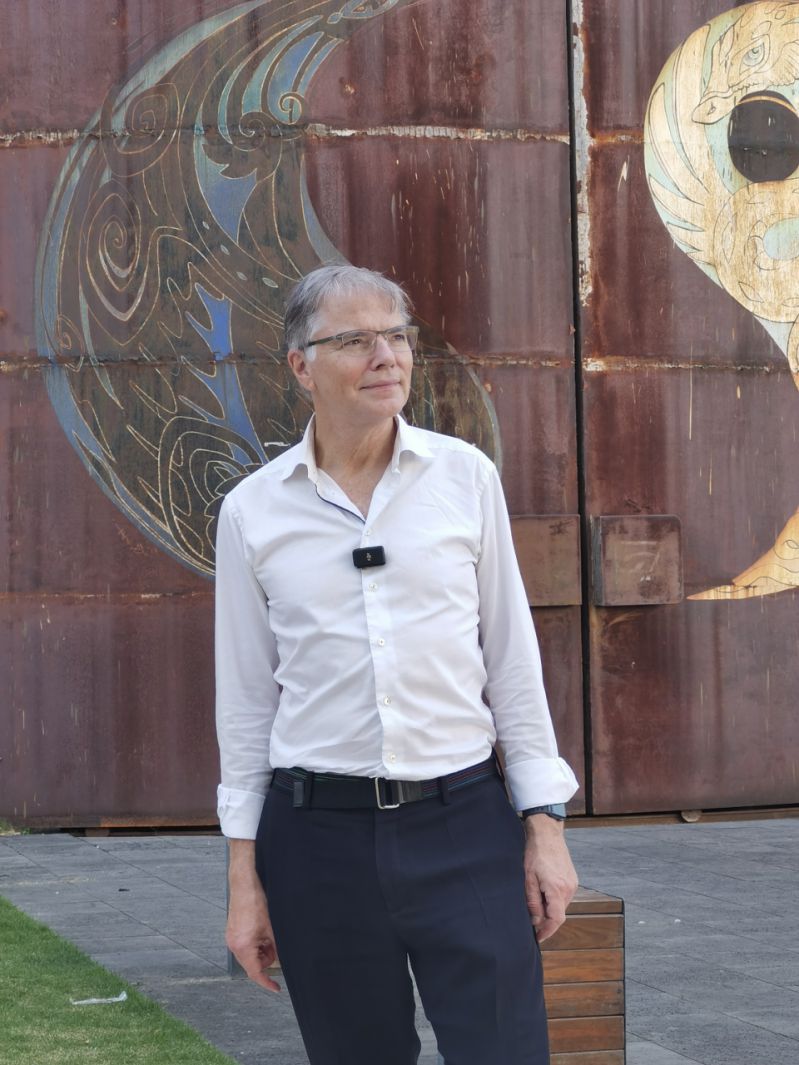
In November 2024, Ole Bouman was interviewed by the reporter from Global People in Shenzhen. (Photo by reporter Li Lulu)
Profile: Ole Bouman, born in 1960 in the Netherlands, has served as the editor-in-chief of Volume magazine and the director of the Netherlands Architecture Institute. He is currently a professor at the College of Architecture and Urban Planning, Tongji University. His major works include The Invisible in Architecture, China in the Everywhere, Architecture with Responsibility, and Design Interconnect: Becoming a Platform for Innovation Aggregation.
Weighing 18 kilograms, his bicycle loaded with 45 kilograms of luggage, Ole Bouman set off on his journey on February 1, 2024, from Amsterdam, embarking on a 10756-kilometer route through 18 countries and one war zone, visiting 500 historical sites along the way. At over sixty years old, Bouman, a professor at Tongji University’s College of Architecture and Urban Planning, began his "Journey to the East," a ride lasting 156 days, before reaching Shanghai and Tongji University.
"This is a journey tracing the Silk Road, a journey of East-West dialogue, and above all, a journey in search of peace," Bouman shared with Global People. "Along the way, I followed in the footsteps of Marco Polo and Xuanzang. For centuries, human communication and dreams have unfolded along these ancient roads. In today’s world, where global tensions are rising, friendship seems to be fading away. Strengthening cultural exchanges between nations is an urgent issue, and this cycling journey is my exploration and answer to that challenge."
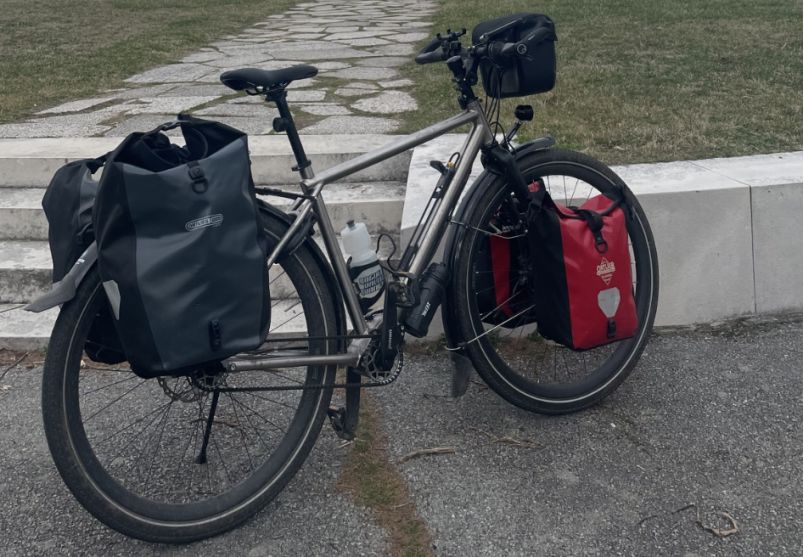
The bicycle of Ole Bouman
Chinese Elements along the Journey
How do Eastern and Western countries communicate with each other? Bouman pondered this question and sought answers throughout his journey. Early on, he paused at the Peace Monument in Amsterdam and stood on top of Lion's Hill at Waterloo in France, gazing down at Napoleon’s final battlefield. From Western Europe to Eastern Europe, he passed through historical sites of World War II and the Holocaust, before reaching the Middle East.
Throughout his journey, Bouman encountered numerous Chinese elements. "In Trier, Germany, I visited statue of Karl Marx, a gift from China to the city. The plaque in front of the statue was written in Chinese: ‘Karl Marx, the most famous son of Trier.’"
In the ancient city of Soltaniyeh in northwest Iran, Bouman visited the tomb of the eighth Ilkhanid ruler, ?ljaitü." ?ljaitü, a descendant of Genghis Khan, ordered the construction of Soltaniyeh. His tomb, housed in a nearly 50-meter-high double-domed building, is one of the oldest of its kind in the world. The azure dome shone brilliantly in the sun—truly magnificent."
As Bouman was about to leave Soltaniyeh, a man on a motorcycle caught up with him, urging him not to miss the nearby "Dragon Valley," where Chinese craftsmen once carved two giant dragons into the rock, commissioned by local rulers.
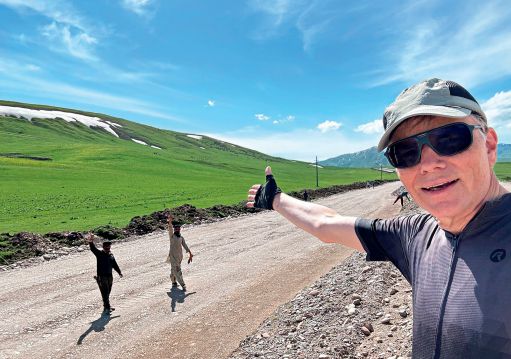
During his ride, Ole Bouman greeted passersby.
On May 10, 2024, Bouman arrived in Xinjiang, China, traveling eastward through Yining and deep into the vast land of China. He visited the ruins of the ancient "Silk Road" city of Jiaohe, experiencing the unique mudbrick architecture; he explored the Xuanzang Memorial Museum in Gansu, learning about the legendary monk’s journey to India; he marveled at the murals of the Mogao Caves in Dunhuang, the "gateway" of the ancient Silk Road; and in Luoyang, he visited the site where Confucius and Laozi once exchanged ideas.
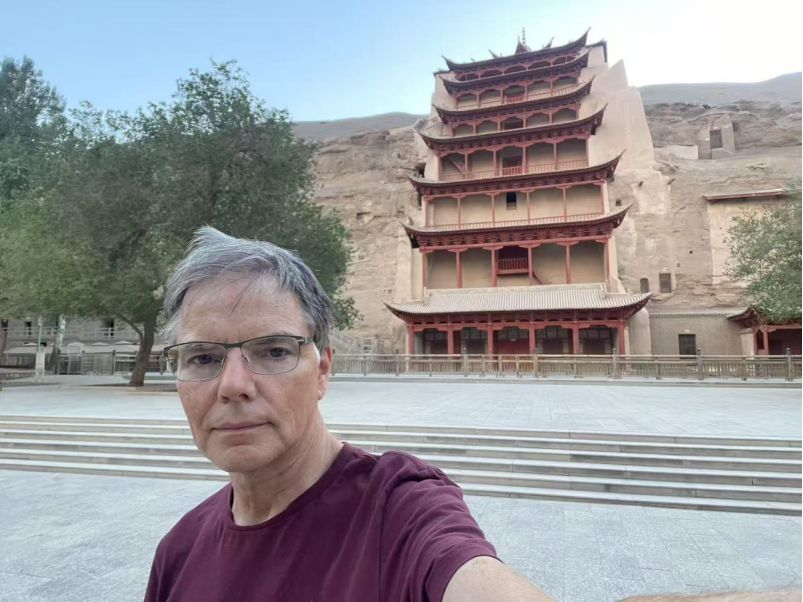
Ole Bouman arrived at the Mogao Caves in Dunhuang
In front of the Memorial Hall of the Victims of the Nanjing Massacre by Japanese Invaders, Bouman was overcome with emotion. "I’ve crossed the Rhine, the Danube, the Euphrates, and the Yellow River, and now, I’ve arrived at the Yangtze River, the second-longest river in Eurasia. I’ve cycled thousands of kilometers along the ‘Silk Road,’ feeling the weight of millennia of history. In Nanjing, this monument silently speaks of the cruelty of war. This city deeply understands and cherishes peace, and it carries the urgent hope that war will never return."
On July 5, 2024, Bouman arrived at the end of his journey—Tongji University in Shanghai. "In the context of global turbulence, how lucky am I to have arrived safely in Shanghai? Perhaps, beyond luck, there’s something else that has guided me to this moment: the universal desire for peace," he reflected.
Throughout the ride, Bouman also integrated the journey into his teaching. Combining online and offline modes, he broke the journey into course units, sharing insights and reflections captured along the way with his students at Tongji University. "On both sides of borders, people can share the same values, tastes, and even food. Beneath these borders, commonality is everywhere—between nations, between ethnicities, between communities, and between individuals," Bouman said.
During his journey, Bouman faced an unexpected challenge. "I originally planned to pass through Iran and head for Turkmenistan, but the conflict between Iran and Israel caused a sudden to visa issuance," Bouman explained. Forced to abandon his Turkmenistan plans, he flew to Dubai, UAE, before heading to Tashkent, the capital of Uzbekistan " Tashkent is not only an important transportation hub, but also a crucial point where East and West meet along the ‘Silk Road.’"
Through these experiences, Bouman developed a deeper understanding of East-West cultural exchanges. "In China, I traced over a thousand years of Buddhism’s spread, experiencing the pursuit of enlightenment and inner peace, before delving into the core area of Taoism and Confucianism," Bouman said. "Though these systems of thought originated differently, they share similarities in their pursuit of social harmony—they are all achieved through time and persistent effort."
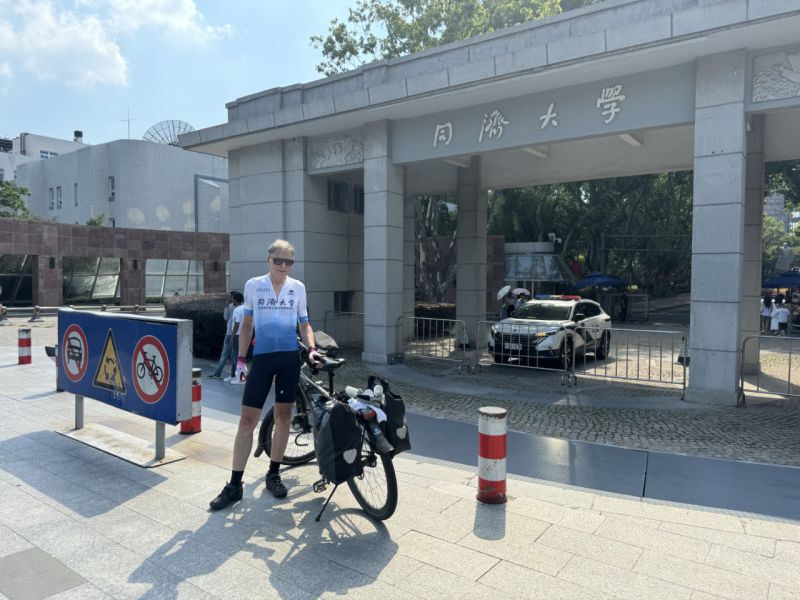
In July 2024, Ole Bouman reached the final destination of his journey, Tongji University.
"Working in China is a Truly Positive Experience"
Bouman was born in Amersfoort, in central Netherlands. He has a Dutch father and a German mother who had come to the Netherlands after World War II. He has five siblings.
After high school, he studied architecture at Delft University of Technology and cultural studies at the University of Amsterdam. He has since worked in various fields, including as a historian, writer, photographer, architect, curator, and professor.
Bouman first visited Shanghai for academic exchange in 2005. "Back then, Shanghai was a city full of potential, offering wonderful views of the buildings and the riverside," he recalls. After multiple visits to China, he decided to settle in Shenzhen, where he embarked on a new chapter of work and life.
In 2015, Bouman, with his rich background in architecture and design, was appointed Director of Design Society in Shenzhen, an innovation and cultural platform, where he contributed to the construction of the Sea World Culture and Arts Center. "The center itself is a piece of art," Bouman said. "The fishing boats docked by the sea represent one of China’s oldest industries, while the distant cargo ships symbolize the boom of China’s manufacturing sector in the 1980s and 1990s. The Shekou Port stretches out from the city’s fabric, connecting Shenzhen and Hong Kong, offering international visitors a more convenient route." So, from near to far, you could say this is a brief summary of China's history, viewed through millennia, centuries, and decades."
Bouman also considers his transformation of the Value Factory in Shenzhen as another masterpiece. Originally the Guangdong Float Glass Factory, in 2013, to promote urban renewal and the development of the cultural industry, Bouman assembled an international design team to protectively renovate the float glass factory and turn it into the new "Shekou Value Factory."
The team preserved the marks of industrial civilization, such as the vast, spacious factory halls and the imposing furnace pillars, while redesigning the site’s landscaping and incorporating new materials into the old environment, giving the factory a fresh, revitalized look. The transformed Value Factory has become an important driving force for Shenzhen's cultural industry, hosting numerous art exhibitions and cultural events, attracting a large number of artists, designers, and visitors for tours and exchanges.
Due to his achievements in architecture and design, Bouman was appointed as a professor at the School of Architecture and Urban Planning at Tongji University in 2022.
"For me, the past decade has brought incredible changes in my career," Bouman said. "My family also moved to China. My child came to Shenzhen when he was one year old, and completing primary school here. His Chinese is excellent." Bouman continued, "And my friends told me that working in China is a very positive experience."
"China is Like a Young Person Who Has Just Woken Up, Full of Energy"
Bouman witnessed firsthand the rapid development of China. He recalls how Shenzhen, Shanghai, and other cities were dramatically different just over a decade ago. "Especially Shenzhen, the changes are astounding. The city used to have no such advanced transportation, no such high-rise buildings. From the top floor of the Value Factory, I could see for miles. But now, I can only see towering skyscrapers." Bouman laughs. "Shenzhen is just one city in China, but its population exceeds that of my home country, the Netherlands. The infrastructure and urban development here are incredibly advanced. In fact, all of China is continuously growing."
Bouman also marvels at China's high-speed rail network. "China is like a young person who has just woken up, full of energy. The people work and grow tirelessly, with many projects surpassing Europe. Walking through the streets of China, I feel the country’ vibrancy."
In Xinjiang, Bouman saw China’s transition to clean and green energy. He believes that China’s development today is increasingly interconnected with its historical culture, natural environment, and ecological resources, all working towards a more balanced and harmonious society.
Bouman has also deeply felt China’s growing influence in the world. "The New Silk Road’s cultural cooperation and the recent BRICS summit in Kazan have made more people aware of China’s scale and influence, and of the significant contributions China is making toward world peace and stability. This is something I felt during my ‘Journey to the East’. Eastern and Western cultures are increasingly blending, and China’s traditional thoughts and value are influencing the world. This includes replacing conflict with dialogue, seeking peaceful development paths, and promoting the shared development of human civilization. China’s growing involvement in global issues is making the concept of “a human community with a shared future” ever clearer. "
(Intern Zhang Linjia contributed to this story.)
 Editor:Li Lulu
Editor:Li Lulu